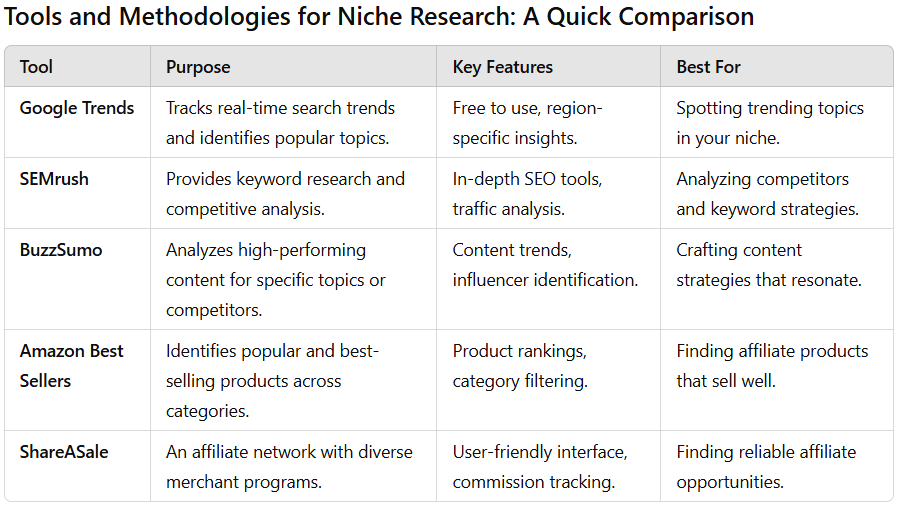Choosing the perfect affiliate program can make or break your success. With so many options available, selecting the right affiliate programs for your niches requires strategy and research. You need programs that align with your audience’s needs, offer fair commissions, and provide quality products. In this guide, we’ll explore how to evaluate programs, balance short- and long-term goals, and ensure every promotion adds value to your niche.
Understanding Your Niche: Laying the Foundation
Defining Your Niche
Your niche is your focus area. It reflects your passions and expertise. For example, if you’re into spiritual healing, that’s your niche. Choosing a niche helps you connect with a specific audience.
Importance of Understanding Your Audience
Knowing your audience is crucial. What are their interests and challenges? For instance, are they seeking emotional healing or time-saving planners? Understanding their needs allows you to create content that resonates.
Assessing the Competitive Landscape
Look at your competitors. What products are they promoting? Analyzing their strategies can reveal market gaps and opportunities. Tools like SEMrush and BuzzSumo can assist in this analysis.
Tools and Methodologies for Niche Research
Effective niche research requires the right tools. Here are some recommendations:

These tools give you a complete picture of your niche’s potential, from audience preferences to competitive insights. Use them to refine your strategy and identify lucrative opportunities.
Evaluating Affiliate Programs: Key Criteria to Consider
Selecting the right affiliate programs is essential for success. It’s not just about commissions; it’s about alignment, trust, and sustainability. Let’s break it down.
1. What Makes a Great Affiliate Program?
Not all programs are created equal. Here’s what to look for:
- High Commission Rates: Programs offering 15% or more are generally worth considering. If the rate is lower, the product should have broad appeal or a high price point.
- Reliable Payments: Consistency matters. Choose programs with clear, transparent payout schedules. Check reviews for any red flags like delayed payments.
- Strong Brand Reputation: A well-known brand is easier to promote. Your audience is more likely to trust it.
💡 Pro Tip: Research the brand’s online presence. A strong social proof (e.g., reviews, and testimonials) can make your promotions more effective.
2. Product Relevance: Does It Fit Your Audience?
Your audience comes first. If the product doesn’t align with their needs, skip it. Imagine promoting a fitness tracker to an audience looking for spiritual healing tools—it’s a mismatch. Instead, think about:
- What challenges your audience faces.
- Products that solve those challenges or enhance their lifestyle.
🗒️ Example: For an audience interested in emotional healing, promoting a guided meditation app or calming aromatherapy kits could be ideal.
3. Balancing High-Ticket and Low-Ticket Items
Diversify your portfolio to maximize earnings:
- High-Ticket Items: These include expensive products or services like online courses, coaching, or luxury goods. They offer big payouts but can be harder to sell.
- Low-Ticket Items: These are affordable products like books, planners, or subscription boxes. They’re easier to sell and can provide consistent income.
💡 Pro Tip: Combine the two. Use low-ticket items to attract beginners and high-ticket ones to engage advanced users or loyal customers.
4. Think Long-Term: Short-Term vs. Recurring Revenue
Affiliate programs often fall into two earning models:
- One-Time Payouts: You earn once per sale. Great for standalone products but requires continuous effort.
- Recurring Commissions: Earn monthly on subscription-based services like software, memberships, or apps. These can provide steady income over time.
🗒️ Example: Promoting a meditation app with a subscription model could earn you commissions every month.
5. Evaluating Program Support and Resources
A good affiliate program supports you with:
- Marketing Tools: Banners, pre-written copy, and promotional materials can save time.
- Dedicated Support: Access to an affiliate manager for questions or concerns is invaluable.
- Tracking Tools: Robust dashboards that track clicks, conversions, and earnings help you measure success.
💡 Pro Tip: Test the program’s customer service before committing. Quick responses can indicate reliability.
Selecting the right affiliate programs means thinking beyond just profits. Focus on relevance, quality, and audience trust. With the right programs, you’ll not only earn more but also build lasting credibility in your niche.
Aligning with Your Audience’s Needs: Ensuring Relevance and Trust
The heart of successful affiliate marketing lies in trust. To win your audience over, your promotions must feel natural, authentic, and tailored to their needs. Here’s how to make it happen.
1. Create Authentic, People-First Content
Forget the hard sell. Today’s audiences value authenticity over flashy sales pitches. Focus on creating content that prioritizes their needs, solves their problems, or inspires them.
🗒️ Example: If your audience is exploring emotional healing, share your personal experience with a guided meditation app. Walk them through how it helped you and why it might benefit them too.
💡 Pro Tip: Use storytelling. Stories are memorable and create an emotional connection.
2. Match Affiliate Offers with Audience Intent
Understanding what your audience wants—and when—is key. Your affiliate offers should align with their intent at every stage of their journey.
Here’s how to match intent:
- Awareness Stage: Introduce low-cost, easy-to-adopt products (e.g., journals or eBooks).
- Consideration Stage: Offer in-depth guides or courses that provide comprehensive solutions.
- Decision Stage: Recommend premium, high-ticket items like one-on-one coaching or subscription services.
🗒️ Example: If your audience is new to manifestation, start with a simple affirmation journal. For advanced users, promote a course on manifestation techniques.
3. Stay Transparent to Build Trust
Trust is everything in affiliate marketing. Always disclose affiliate links. Transparency shows respect for your audience and builds credibility.
Use simple language like:
“This post contains affiliate links, meaning I may earn a small commission if you purchase through them—at no extra cost to you.”
💡 Pro Tip: Include disclosures at the top of the post and near affiliate links. Don’t hide them in fine print.
4. Share Case Studies or Personal Success Stories
Sharing real-world success stories creates credibility. People want proof that a product works, and nothing beats firsthand experiences.
🗒️ Example: If you’re promoting a planner, show how it helped you organize your day or manage stress. Include before-and-after photos or screenshots of results.
💡 Pro Tip: Collaborate with brands to share testimonials from other customers as well.
5. Engage Your Audience with Feedback
Engagement is a two-way street. Ask your audience for feedback about the products you promote. Their insights can guide your future promotions and deepen trust.
Questions you could ask:
- “Have you tried this product? How did it work for you?”
- “What’s your biggest challenge in [your niche]? I’d love to help!”
💡 Pro Tip: Use surveys, polls, or comment sections to encourage interaction.
Aligning with your audience’s needs is about building relationships, not just making sales. When you prioritize their interests and stay genuine, they’ll trust your recommendations—and keep coming back.
Measuring Success and Optimizing Strategies: Continuous Growth

Affiliate marketing isn’t a set-it-and-forget-it game. Success comes from tracking results, experimenting, and constantly improving. Let’s explore how to measure performance and optimize your strategies for long-term growth.
1. Understand the Metrics That Matter
Tracking the right metrics gives you a clear picture of what’s working—and what isn’t. Here are three key metrics to monitor:
- Conversion Rate (CR)
The conversion rate measures the percentage of people who take a desired action, such as making a purchase or signing up for a service, after clicking your affiliate link.- Formula: (Number of Conversions ÷ Total Clicks) × 100
- Why it matters: A high CR means your audience finds your offer compelling. A low CR might indicate mismatched products or weak calls to action.
- Click-Through Rate (CTR)
The CTR tells you how often people click your affiliate links compared to how many people see them.- Formula: (Number of Clicks ÷ Number of Impressions) × 100
- Why it matters: A low CTR might mean your content isn’t engaging enough or the link placement isn’t effective.
- Return on Investment (ROI)
ROI evaluates the profitability of your efforts by comparing what you earned to what you spent.-
- Formula: (Net Profit ÷ Total Investment) × 100
- Why it matters: A positive ROI shows your affiliate strategy is worth the time and money you’re investing. If it’s negative, it’s time to pivot.
-
💡 Pro Tip: Use tools like Google Analytics, Bitly, or affiliate dashboards to monitor these metrics. Read How to Drive Traffic to Your Affiliate Links.
2. Harness the Power of A/B Testing
What is A/B Testing?
A/B testing is the process of comparing two versions of something—like a blog post headline, call-to-action button, or affiliate link placement—to see which performs better.
🗒️ Example:
- Test one blog post with a product mention at the top.
- Test another with the mention at the bottom.
- Measure which one generates more clicks or conversions.
💡 Pro Tip: Test only one variable at a time to get clear results. Use tools like Optimizely or Google Optimize for advanced A/B testing.
3. Continuously Review and Update Your Strategy
Why Review Regularly?
The affiliate marketing landscape changes quickly. Products go out of style, audience needs shift, and competitors adapt. Reviewing your strategy helps you stay relevant.
🗒️ How to Review:
- Set a Schedule: Conduct monthly or quarterly performance reviews.
- Analyze Metrics: Look at CR, CTR, and ROI for each campaign. Identify underperforming content or products.
- Refresh Content: Update blog posts, add fresh insights, and remove outdated links.
- Explore New Trends: Research new tools, platforms, or affiliate programs that fit your niche.
💡 Pro Tip: Keep a spreadsheet to track what’s working and what isn’t over time.
4. Use Feedback Loops to Refine Your Strategy
Feedback loops are about listening, learning, and improving. Use audience input to fine-tune your approach. For example:
- Monitor comments, emails, or social media for product-related feedback.
- Use surveys to ask what your audience wants more of.
🗒️ Example: If readers say a product didn’t work as expected, consider switching to a better option.
💡 Pro Tip: Act on feedback quickly to show your audience you value their opinions.
Success in affiliate marketing is all about iteration. Track your progress, test new ideas, and adapt to changes in your niche. With the right mindset and tools, you’ll keep growing and achieving better results over time.
Final Thoughts
Affiliate marketing success comes from strategy, trust, and consistent improvement. First, understand your niche and audience. Then, choose affiliate programs that align with their needs. Focus on creating authentic, helpful content to build trust. Track key metrics and adjust strategies regularly to optimize results. Remember, growth takes time and effort, but it’s worth it.
What’s your biggest challenge with affiliate marketing? Leave a comment below—I’d love to help!
This post contains affiliate links, meaning I earn a commission if you purchase through my link at no extra cost to you.

